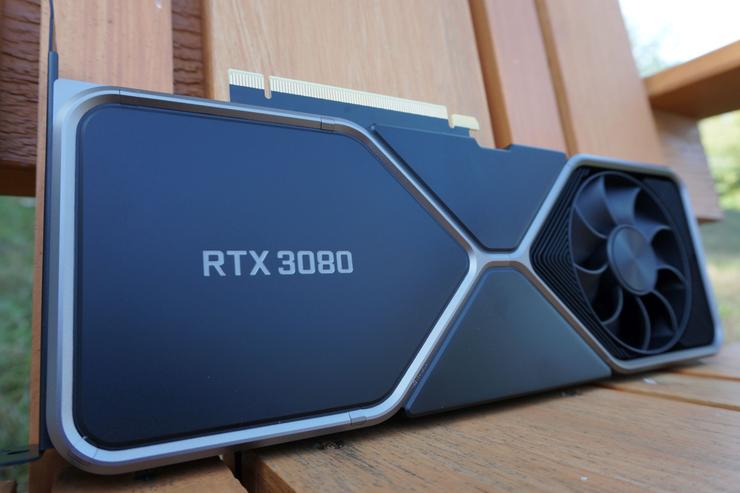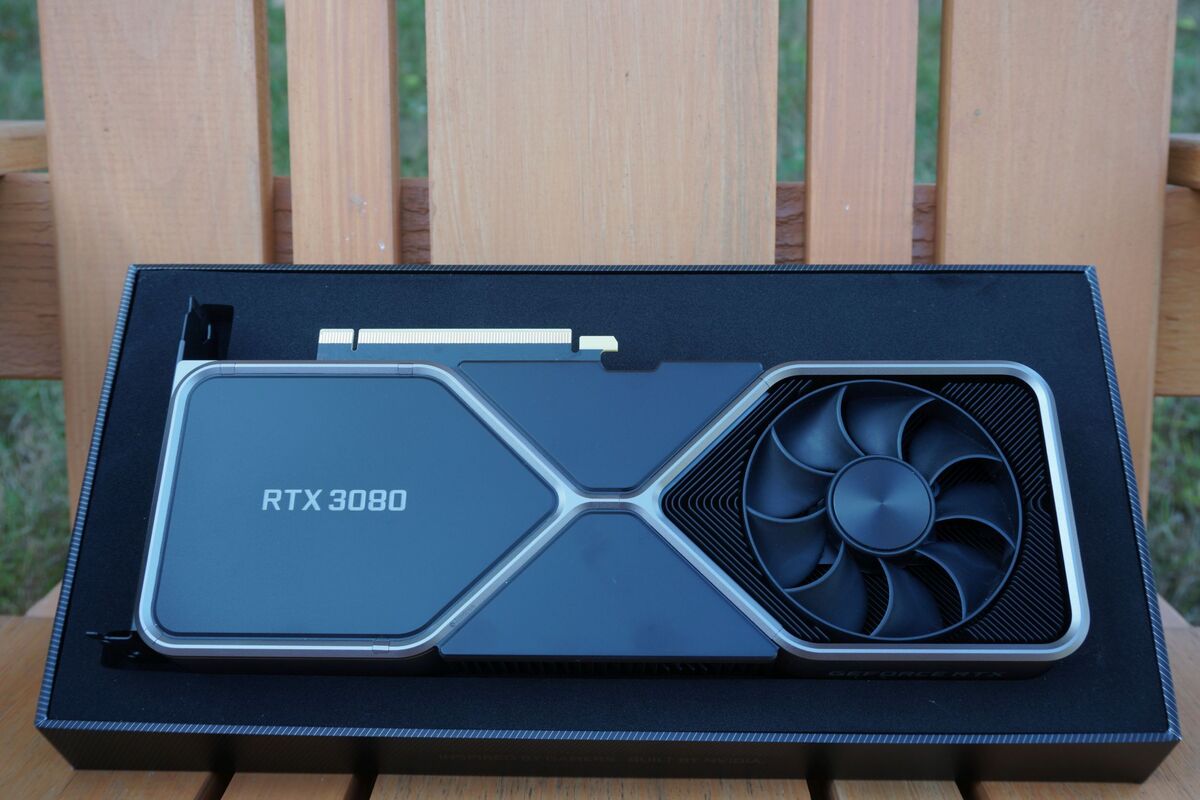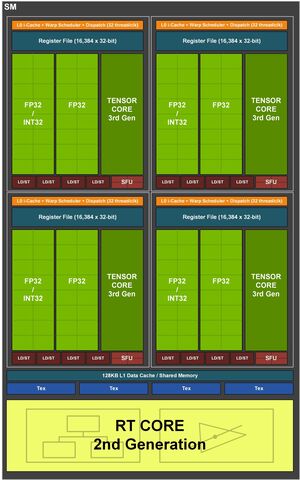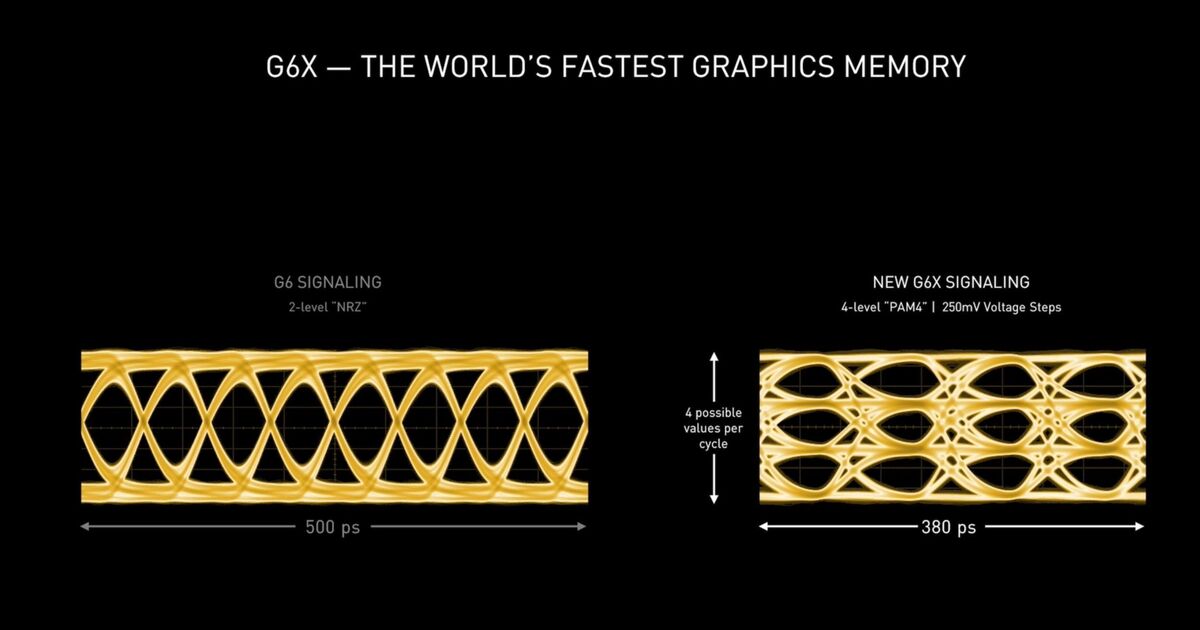 Credit: Brad Chacos/IDG
Credit: Brad Chacos/IDG
Nvidia’s GeForce RTX 3080 graphics card symbolizes why we tell people to wait for the second generation when bleeding-edge technology appears.
The radical new-look Turing GPUs inside Nvidia’s GeForce RTX 20-series packed all sorts of cutting-edge technologies designed to usher in real-time ray tracing, a long sought-after goal for the gaming industry. Not only did Turing introduce specialized RT cores devoted to processing ray tracing tasks, it also debuted tensor cores, dedicated hardware that uses machine learning to help denoise ray traced visuals and enable AI-enhanced tools like the fantastic Deep Learning Super Sampling (DLSS) technology. Turing’s improvements also extended to the traditional shader cores, introducing an overhauled processing pipeline better equipped to handle games built using the newer DirectX 12 and Vulkan graphics APIs. All of these were huge departures from the norm.
But new doesn’t always mean great. While the RTX 20-series indeed birthed a new ray-traced era, games that supported ray tracing or DLSS were few and far between over its lifetime. Worse, the RTX 20-series cards offered essentially the same performance in traditional games as their older GTX 10-series predecessors at the same price point. The initial reception (and sales) weren’t glowing.
The $699 GeForce RTX 3080 and Nvidia’s new Ampere GPU architecture changes all that. This thing freakin’ smokes. It’s a massive upgrade over the older $699 GeForce RTX 2080, significantly faster than the former $1,200 RTX 2080 Ti flagship, and if you’ve been holding onto your older GeForce GTX 1080? The GeForce RTX 3080 absolutely crushes it. This is an excellent graphics card for 4K and ultra-fast 1440p gaming—if you can afford it when it launches on September 17.
Editor’s note: This comprehensive review of the GeForce RTX 3080 goes longer than most as it’s our first evaluation of an Ampere-powered GeForce RTX 30-series graphics card. Check out Nvidia GeForce RTX 3080 tested: 5 key things you need to know for high-level takeaways of this in-depth info, or use this table of contents to hop between the various sections of the review.
- GeForce RTX 3080: Specs, features, and Ampere
- Founders Edition design
- Our test system
- Gaming benchmarks
- Ray tracing and DLSS benchmarks
- Power draw, thermals, and noise
- Should you buy the GeForce RTX 3080 Founders Edition?
GeForce RTX 3080: Specs, features, and Ampere
 Brad Chacos/IDG
Brad Chacos/IDGBefore we dive into what’s new in the GeForce RTX 3080, here’s a high-level look at the Founders Edition card’s specifications. You can find more info about how it stacks up against the previous generation in our GeForce RTX 30-series vs. RTX 20-series spec comparison.
- CUDA cores: 8,704
- Boost clock: 1.71GHz
- Memory: 10GB GDDR6X at 9500MHz
- Memory bus: 320-bit
- Memory bandwidth: 760GB/s
- RT cores: 68 (2nd-gen)
- Tensor cores: 384 (3rd-gen)
- NVLink SLI: No
- PCIe: Gen 4
- HDMI: 2.1
- HDCP: 2.3
- Display connectors: 1x HDMI 2.1, 3x DisplayPort 1.4
- Length: 11.2 inches
- Width: 4.4 inches
- Height: 2-slot
- Maximum GPU temp: 93
- Graphics card power: 320W
- Recommended power supply: 750W
- Power connectors: 2x 8-pin (with supplied 12-pin adapter)
Got it? Good. Now we’re going to get geeky for a bit. Skip to the next section if you aren’t interested in some deeper details on how the tech inside the GeForce RTX 3080 works.
 Nvidia
NvidiaThe beating heart inside the GeForce RTX 3080 is Nvidia’s new GA102 “Ampere” GPU. Ampere is built using Samsung’s 8nm processor node, moving up from the TSMC 14nm and slightly modified 12nm nodes used for the GTX 10- and RTX 20-series cards, so this is a generational leap for Nvidia. The last time Nvidia leaped a node, the GeForce GTX 10-series demolished their direct predecessors. It’s no different this time around, as you’ll soon see.
 Nvidia
Nvidia
Inside an RTX 30-series Ampere SM.
While Turing shook up GPU design, Ampere builds on Turing’s foundations. Turing’s simultaneous multiprocessors (SMs)—the building blocks of the GPU—received a significant overhaul, adding a new integer pipeline (INT32) alongside the floating point pipeline (FP32) traditionally used to process shading. The new pipeline let Nvidia’s GPU handle integer instructions at the same time as traditional FP instructions, giving Turing-based graphics cards a big speed boost in games that leaned heavily on those tasks—namely, well-optimized Vulkan and DirectX 12 games. Performance in traditional games stayed largely stagnant in the RTX 20-series graphics cards, however, partially because FP32 is generally more important for gaming workloads.
Ampere both builds on Turing and scales back that design by doubling the number of CUDA cores in each SM. The new architecture introduces a data path devoted exclusively to those crucial FP32 tasks, while a second path can process either INT or FP tasks. That makes Ampere much faster at traditional game rendering.
Note that overall game performance doesn’t scale up perfectly with CUDA core counts, especially because INT instructions can now potentially eat into the total FP throughput on that second path. All in all, it’s a good, reasonable tweak. To feed the beasts, Nvidia doubled the bandwidth and partition size of the L1 cache in each SM, along with adding 33 percent more L1 capacity.
Those specialized RT and tensor cores also received upgrades—the RT cores to a second-generation version, and the tensor cores to the third generation. There are more RT cores crammed into the RTX 3080, and fewer tensor cores. But these third-gen tensor cores are much more capable than their predecessors, enabling higher performance despite the reduced count.
The RT cores also gained the ability to interpolate triangle position. This particularly helps in scenes with motion blur, potentially speeding up ray traversal by 8X. Overall, Nvidia says its new RT cores are 1.7X faster than before, while the tensor cores are 2.7X more efficient—though again, that doesn’t scale perfectly to actual gaming performance.
 Nvidia
NvidiaThose gains are boosted even further by Ampere’s newfound ability to run tasks on the tensor and RT cores simultaneously. In Turing, ray-traced tasks ran alongside shader functions, but the GPU needed to finish that ray-traced task and hand it to the tensor cores for denoising and DLSS before spitting out the final image. In Ampere, tensor cores can run DLSS to upscale one frame while the shader and RT cores work on the next one, all three process tasks running simultaneously. Paired with the improved shader capabilities, a frame that took up to 13 milliseconds to run on Turing with ray tracing and DLSS enabled can now be spit out in 6.7ms with Ampere. Hot damn.
Bottom line? Improvements in the Ampere GPU architecture give a big boost to performance in both traditional games as well as games that leverage Nvidia’s RTX capabilities.
But the GeForce RTX 3080’s gains don’t come solely from the new Ampere architecture. Like the GTX 1080 and RTX 2080 before it, Nvidia’s latest flagship introduces cutting-edge memory, too. This time around, the GeForce RTX 3080 (and forthcoming RTX 3090) tap Micron’s blazing-fast GDDR6X memory modules. Micron’s memory rolls out “PAM4” signaling technology, which lets them send four possible values per cycle, up from the traditional two. That lets GDDR6X move data twice as fast as previous incarnations. The 10GB of GDDR6X memory in the RTX 3080 sends that data over a 320-bit bus, for a total memory bandwidth of 760GBps. By comparison, the GeForce RTX 2080 Super’s 8GB of non-X GDDR6 used a 256-bit bus for 496GBps of overall bandwidth.
 Nvidia
Nvidia
Traditional GDDR6 vs. the RTX 3080’s GDDR6x memory.
Nvidia also tweaked how the memory works to improve its efficiency—a good thing, as the 320W GeForce RTX 3080 draws noticeably more power than even the previous-gen RTX 2080 Ti flagship. The company added 250mV voltage steps and new “max transition avoidance coding” to take advantage of the four-signal PAM4 memory without having the chips swing wildly from the lowest to highest values, which could cause energy arcs. Nvidia also gave the graphics core and memory system their own dedicated power rails, letting the GPU fine-tune the power levels of each separately for greater efficiency. Previous chip designs used a shared power rail for the two.
Now that we’re talking power, it’s a great time to shift gears to the design of the GeForce RTX 3080 Founders Edition.
Next page: RTX 3080 FE design

















